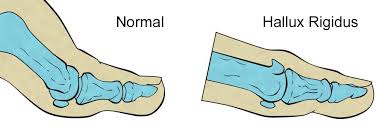
Hallux rigidus is a type of arthritis that affects the big toe joint. It occurs when there is damage or degeneration of the cartilage that covers the ends of the bones in the joint, leading to pain, stiffness, and limited range of motion in the big toe.
Symptoms of hallux rigidus include pain and stiffness in the big toe joint, especially during activities such as walking, running, and climbing stairs. There may also be swelling and tenderness in the joint, and the toe may become crooked or appear larger than normal.
Treatment for hallux rigidus depends on the severity of the condition and may include conservative measures such as wearing shoes with a wide toe box and cushioned soles, using custom orthotics to support the foot and reduce pressure on the joint, and taking non-steroidal anti-inflammatory medications (NSAIDs) to relieve pain and reduce inflammation.
If conservative measures are not effective, surgery may be necessary to remove bone spurs, replace or fuse the joint, or realign the toe. In severe cases where joint replacement or fusion is required, physical therapy and rehabilitation may be necessary to help restore function and mobility.
Early diagnosis and treatment are important for preventing the progression of hallux rigidus and preserving joint function. If you are experiencing symptoms of hallux rigidus, it is important to seek medical attention for an accurate diagnosis and appropriate treatment.
